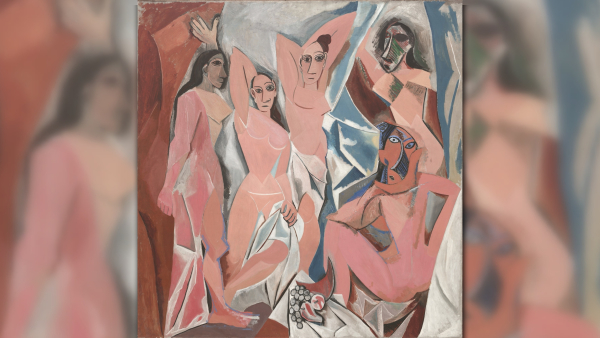Cubism is an avant-garde European artistic movement that emerged in France at the beginning of the 20th century and is characterized by use of geometric shapes to portray nature.
Cubism was founded in Paris, through the renowned Spanish artist Pablo Picasso (1881 - 1973) and the French Georges Braque (1882 - 1963).

Les Demoisellers d'Avignon (1907), Pablo Picasso
The board "Les demoisellers d'Avignon" (or “The Misses of Avignon”, in Portuguese), from 1907, authored by Picasso, is considered the starting point of this innovative movement.
In general, Cubism is marked by the representation of figures from nature through the use of geometric shapes, promoting the fragmentation and decomposition of plans and perspectives. The cubist artist is no longer committed to using the real appearance of things, as happened during the Renaissance.
Cubist art is considered a “mental art”, where each aspect of the work must be analyzed and studied individually.
Cubes, cylinders and spheres are some of the usual shapes in Cubism, which are distinguished from abstract art by the concrete use of all forms.
In addition to Picasso and Braque, other artists who were immortalized as icons of this vanguard are Juan Gris (1887 – 1927) and Fernand Léger (1881 – 1955).
phases of cubism
The Cubist movement was marked by three phases: Cezannian Cubism (1907 - 1909), Analytical Cubism (1910 – 1912) and Synthetic Cubism (1913 – 1914).
Cezannian Cubism or Pre-analytic Cubism (1907 - 1909)
Also known as “pre-analytic cubism”, this is considered the initial phase of the cubist movement (1907 – 1909), where the main basis was the work of Cézanne, with a strong influence of African art and due to the use of forms simplified.
The works of Paul Cézanne (1839 - 1906) served as inspiration for the consolidation of Cubism. Although they did not yet have all the characteristics that define the artistic movement, some concepts adopted by Cézanne in his works were fundamental for Picasso and other artists to build the style cubist.
Example of work from Cezannian Cubism

self portrait (1907), Pablo Picasso
Analytical Cubism (1909 - 1912)
It is seen as “pure cubism” and difficult to interpret, where the figures are decomposed through the use of different geometric shapes.
With a strong influence on African art, the works in this period permeate monochromatic tones, with a predominance of green, brown and gray. Furthermore, there is also a need to express nature in a simplified way, with straight and uniform lines.
Example of Analytical Cubism Work

Violin and Candlestick (1910), Georges Braque
Synthetic Cubism (1913 - 1914)
The great feature of this phase was the introduction of collage technique to reconstruct the images that were once decomposed. Therefore, this period is also known as "Collage Cubism".
Unlike analytical cubism, at this stage the images start to maintain their physiognomy, but in a reduced way, presenting only what is essential for their recognition.
The main precursor of synthetic cubism was Juan Gris (1887 – 1927), who also started to use a palette of more vivid and intense colors in his works.
Examples of Synthetic Cubism Works

Guitar (1913), Pablo Picasso

Landscape at Ceret (1913), Juan Gris
Characteristics of Cubism
Among some of the main characteristics of cubism, the following stand out:
- Use of geometric shapes and volumes;
- Decomposition of images into geometric shapes;
- Reconstruction of images through the use of collages;
- Renunciation of the use of perspectives, especially three-dimensional ones;
- Closed colors (predominance of white, black, gray, brown and ocher);
- Sculptural painting.
Learn more about main features of cubism and The Types of Art.
Cubism in Brazil
In Brazil, the first manifestations of Cubism emerged after the Week of Modern Art in 1922, but the movement did not have the same strength as it had in Europe.
No Brazilian artist used the pure and brute essence of European Cubism, however, some of the characteristics of this movement were adopted by Tarsila do Amaral (1886 – 1973), Anita Malfatti (1889 – 1964), Rego Monteiro (1899 – 1970) and Di Cavalcanti (1897 – 1976).
But, the importance that Cubism had in the conception of other artistic movements in the beginning of the 20th century and that had great repercussion in Brazil, such as the Concretism.

Sao Paulo (1924), Tarsila do Amaral
cubism in literature
The Cubist avant-garde also reached other artistic branches, such as literature.
In this case, literary cubism focused on the idea of "destruction" of syntax. The verses were fragmented and discontinuous, that is, there is no linearity in the narrated story.
One of the main names in this literary movement was the French poet Guillaume Apollinaire (1880 – 1918).
Learn more about the meaning of Modern Art.

